1932 - Radio Talk on Echo Sounding by Dr. Herbert Grove Dorsey
The following talk was presented by Dr. Herbert Grove Dorsey, chief of the Coast and Geodetic Survey Radiosonic Laboratory, on September 16, 1932. Dr. Dorsey had worked for Submarine Signal Corporation prior to 1925 when he chose to make a career with the Coast and Geodetic Survey. Although not working in submarine acoustics at the time of Reginald Fessenden’s submarine signaling experiments in 1914, he was a colleague of Fessenden’s in the early 1920's. Dr. Dorsey presented this talk in a familiar folksy manner as his audience was scientifically-minded people in the United States who listened to the short science presentations given by Science Service over the Columbia Broadcasting System (CBS).
Although Dr. Dorsey allowed himself a little whimsy in this talk, he fills a void in the history of the evolution of sounding instruments in the United States. Through his amplifier coupled with his invention of the Fathometer, an electro-mechanical sounding instrument, he was able to develop a means of measuring both very shoal water and very deep water with the same instrument. His fathometers increased the efficiency of hydrographic surveying for the Coast and Geodetic Survey and also proved to be of great value to the maritime shipping industry. His term, fathometer, was adapted by Submarine Signal Corporation and became a standard term for many different types of depth measuring instruments over the next 30 to 40 years. His instruments helped delineate much of the continental shelf and slope of the United States and its territories as well as much of the deep sea, in particular the northeast Pacific Ocean, the mid-Atlantic shelf and slope, and Gulf of America.
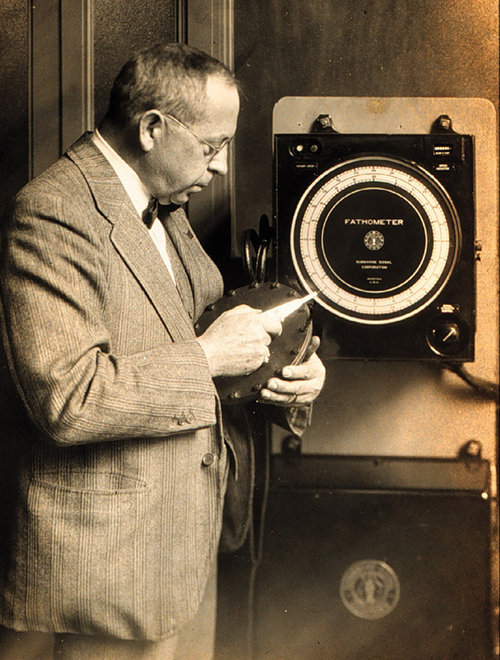
Herbert Grove Dorsey invented the fathometer. Dorsey came to work as the chief physicist of the Coast and Geodetic Survey (C&GS) in 1926. Image courtesy of NOAA Photo Library. Download image (jpg, 44 KB).
Echoes Give Ocean Depths
Dr. Herbert Grove Dorsey
Principal Electrical Engineer,
United States Coast and geodetic Survey
A Radio Talk presented Friday, September 16, 1932, under the auspices of Science Service over the Columbia broadcasting System.
HELLO, EVERYBODY! Hello, Everybody! SOUNDS FUNNY, DOESN’T IT? Sounds Funny, Doesn’t It? ECHO! Echo! Yes, I am going to talk to you about echoes. Echoes, which are made by sounds reflected back to you, are heard on all sides and by everybody, you are so used to hearing them that they are seldom noticed unless the echo is heard at a considerable time interval after the sound is produced. In a room with bare walls we hear the echoes so quickly that the result is called reverberation and considerable money is spent preventing reverberation in a broadcasting studio.
Being so common, you would scarcely believe that echoes are useful and can save time and money as well as promote safety at sea.
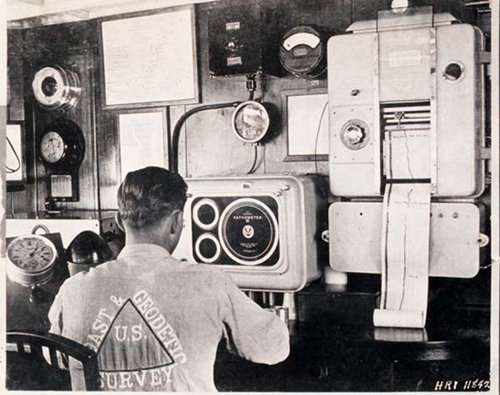
A crewman operates a light-registering fathometer while wearing a home-designed U. S. Coast and Geodetic Survey logo embossed work shirt. Image courtesy of NOAA Photo Library. Download image (jpg, 58 KB).
Safety at sea was on everybody’s lips after the tragic disaster of the TITANIC, twenty years ago. How could the sea be made safer; how could we know when icebergs might be near enough to cause danger? Many minds were turned towards a solution of this problem and one mind, at least, though of the possibility of receiving a submarine echo from an iceberg by a sound produced in water. The experiment was actually tried by Prof. Reginald A. Fessenden and whether he received echoes from the iceberg seems to be omitted from the record. But he did succeed in getting echoes from the bottom of the ocean, which was perhaps more important, for the sea always has a bottom while you can’t find icebergs on every little summer’s outing at sea.
While you get echoes so easily in air you will be surprised to know that you can hear them more easily in water, for sound travels better in water than in air, travels faster and farther. It passes through water so much faster, about four and one-half times, that it is not easy to measure shallow ocean depths by the echo method because the time interval is so short. In water, sound travels about 4,800 feet per second and since a fathom is six feet the sound will go down and back through a depth of 400 fathoms in one second, or through a depth of one fathom in one four hundredth of a second, which is only two and one-half thousandths of a second. We think of a stop watch measuring to a fifth of a second as being very fast. It used to be the last word in timing horse races, but in this day and age, when we hear so much about split seconds, it is entirely too long even for races!
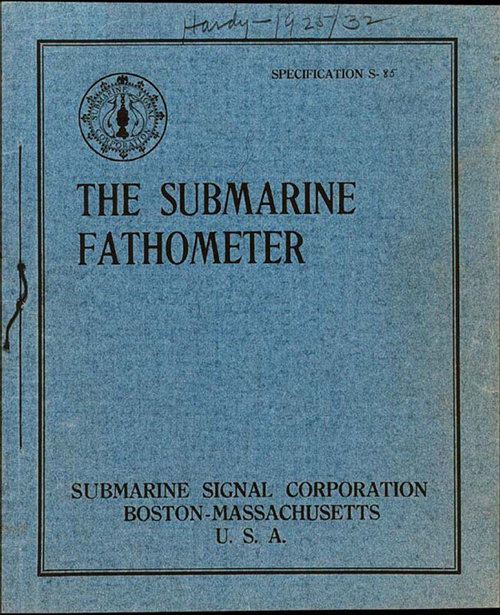
Title page to manual - "The Submarine Fathometer." Fathometer invented by Herbert Grove Dorsey of the Sub Signal Corporation. Image courtesy of NOAA Photo Library. Download image (jpg, 113 KB).
Measuring ocean depths is probably as old as the art of sailing ships, for Herodotus some four hundred years B.C. mentions putting grease on the bottom of the sinker to bring up a sample of the bottom. No practical improvements were made for 23 centuries until Lord Kelvin utilized the idea of pressures tubes, which was still further improved in accuracy by Commander G. T. Rude of the Coast and Geodetic Survey. While Fessenden’s method would work in deep water , it was cumbersome, requiring a skilled observer to use head phones and listen intently to distinguish the difference between echoes and water noise, and it was absolutely impossible to measure shallow depths with it. Ship captains were not interested in it and nothing was done commercially. Although several attempts were made to produce something better, Fessenden’s model lay practically dormant until 1922.At that time the Submarine Signal Company put two of its engineers on the problem, R.L. Williams and myself. Williams was a mechanical engineer unfamiliar with radio, while I had just completed experiments on the radio loud speaker, now so extensively used. Naturally, we attacked the problem along different lines, he holding to mechanical devices while I tried to tune everything and amplify the weak echoes. This desire to amplify was ridiculed because it was thought impracticable to attempt to use amplifying tubes on a ship unless under the constant supervision of the wireless operator. Of course amplification helped and proved to be the only way to success. On an experimental trip on the Ship CALAMARES, the captain asked me if I could measure shallow depths and said “When you can measure six to ten fathoms, you will be doing something!” It was not long after that until I had a visual method worked out in the following manner.
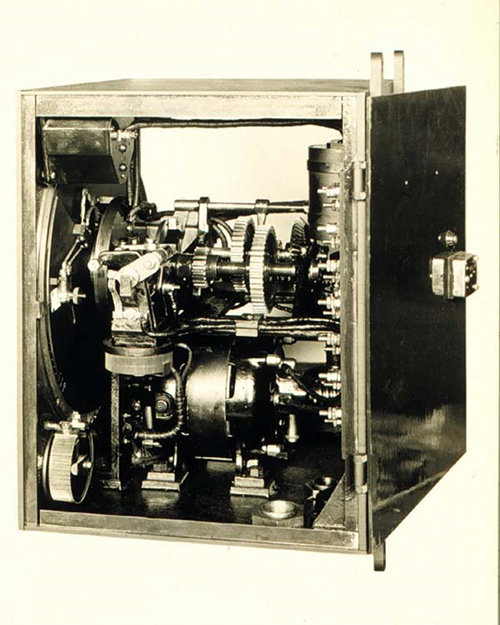
Internal view of fathometer from the manual, "The Submarine Fathometer." Image courtesy of NOAA Photo Library. Download image (jpg, 78 KB).
In one part of equipment, called the indicator, there is a small motor with a governor which, through a system of gears, rotates a black disc four times per second. Attached to the back side of the disc is a tiny neon tube, just a small edition of the same as is used in advertising signs, and when it is illuminated its red light shines through a slot in the disc but is lighted only now and then. In front of the disc is a sheet of glass on which is painted a circular scale marked in fathoms form zero to 100. Every time the neon tube passes the zero point of the scale, an electric current passes through a sounder bolted to the bottom of the ship and a sound is produced as a short whistle blast, two octaves above middle C, like this: (Illustrate by whistling the short blasts for two seconds), only these sounds pass into the water. No wire is lowered, nothing is dropped, no connection with the bottom is made. The sounds themselves do the work by being reflected from the bottom of the ocean as echoes.
As the echoes return to the ship they are “heard” by a receiver of submarine sounds, or electric ear as it might be called, and are amplified using thermionic tubes, similar to those by which you are now hearing my voice, increases the loudness of the echoes so that the electrical energy will cause the tiny neon tube to make a single brilliant instantaneous red flash of light as the tube whirls around with the disc. This flash will shine through the glass, opposite some mark on the scale, six fathoms for example, if that happens to be the depth of water through which the ship is passing. Four times a second the red light flashes at six fathoms, thus measuring a time interval of only fifteen thousandths of a second, and you read the depth as easily as you read time on a clock.. Now, as the ship travels through deeper water, the red flashes will occur at later intervals, making the indications move along the scale to show increasing depths. In going from deep water to shallow, of course the red flashes will follow the scale backwards just as well as forwards. If the depth increases to more than a hundred fathoms a handle is turned shifting to a slower speed and another scale, so that, while the indications come less often, the depths can be measured to 3,000 fathoms or more, nearly 31/2 miles of water.

Fathometer Filter. From the manual, "The Submarine Fathometer." Image courtesy of NOAA Photo Library. Download image (jpg, 94 KB).

Fathometer oscillator from the manual, "The Submarine Fathometer." Image courtesy of NOAA Photo Library. Download image (jpg, 65 KB).
Since the instrument measures fathoms, I named it Fathometer, and as such the fathometer is now used on hundreds of ships measuring fathoms whenever the captain wishes. In former days, he would have to slow up the ships, if the water were shallow, or stop if it were deep, while now he presses a button, the fathometer starts and after a few reading to assure himself that he has plenty of water he pushes another button. It is all finished in a few seconds, even though the depth be a thousand fathoms! By the method of lowering a wire to measure this depth, the ship must be stopped at lease a half hour, while now it can proceed a t full speed twenty to thirty knots, and in any kind of weather, day or night. With the fathometer right in the pilot house, the skipper has no anxiety about the depth.
In the United States Coast and Geodetic Survey, we are using fathometers on thirteen ships to chart the ocean depths. Since we can run the ships at full speed, we can get many more soundings than formerly, not only doubling the speed of hydrographic surveying, but getting so many more soundings that we can make charts better and faster at lower costs than by the former, slower methods. With a ship speed of ten knots and four soundings per second, the depth is obtained about every four feet, so that even slight changes in ridges and valleys are now found which might not have been noticed by old methods. Every so often our ships are stopped and very careful measurements made with a wire and lead sinker, and serial temperatures of the water are taken so as to get an accurate correction on the fathometer, to keep it calibrated as a precision instrument. A little grab bucket at the end of the wire brings up a sample of the bottom. The fathometer cannot do that, but as one watches the red flashes he can get some idea of the bottom, for the echoes are less regular from a rocky bottom than from a smooth one.
As greater details are given in our charts, navigators are finding them much more useful than just mere road maps of directions at sea. The bottom is seldom flat for any considerable area and, if a navigator is lost in a fog, he can keep his fathometer running a few minutes, mark the indications on a piece of thin paper and by moving this around over the chart he will find some line on which his soundings will agree with those of the chart, keeping it parallel with his course, locating not only his position and direction of travel, but giving also his speed. Thus, “in a couple of nut shells” as Andy would say, “he knows where he is at.” So vivid are the fathometer indications when steaming over rapidly changing depths that it is almost like seeing the bottom rise and fall as do the hills and valleys by the road side as you ride along in an automobile. The configuration of the ocean bottom is not unlike that of our land surfaces; sometimes changing so rapidly that it almost resembles cliffs, palisades and canons. I have measured slopes in the China Sea and in the Pacific near San Francisco, which have about the same average grade as the mountains near the coast, while the ocean bed to the east of north Florida, while having a gentle slope towards Spain, is as flat as the State of Florida itself.
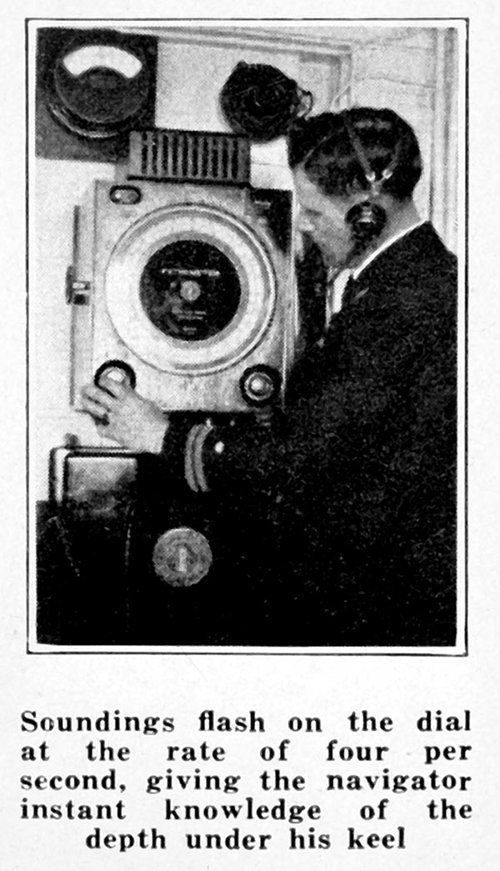
Operator using Dorsey Fathometer with flashing light method Merchant Marine Bulletin No. 9, May 1931. Image courtesy of NOAA Photo Library. Download image (jpg, 94 KB).
What to you suppose the fish think about all this whistling? Well, by watching them, in clear water, when the fathometer is first started, they appear frightened and rush away from the sound; but after ten or fifteen seconds they get used to it and swim around the ship as usual. Dog fish might try to bark at it–who knows?
Herodotus probably knew about echoes as well as about grease on the bottom of the sinker, but I would like to watch his reaction to a fathometer while sailing the Aegean Sea.
Citation: Dorsey, Herbert Grove, Principal Electrical Engineer, United States Coast and Geodetic Survey. 1932. Echoes Gives Ocean Depths: A Radio Talk presented Friday, September 16, 1932, under the auspices of Science Service over the Columbia Broadcasting System. Science Service, Columbia Broadcasting System, Washington, D.C. Unpublished Mimeograph. Held by NOAA Central Library.
Note on Transcription: Typed transcript prepared by NOAA Central Library staff April 2002.